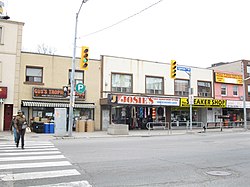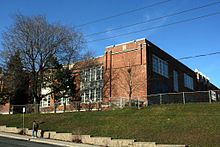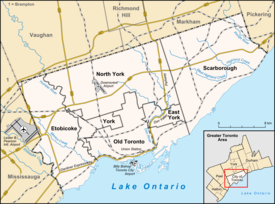Fairbank, Toronto
Fairbank | |
|---|---|
Neighbourhood | |
 View of Fairbank from Oakwood andEglinton Avenuebefore the construction ofOakwood station | |
 Vicinity | |
| Coordinates:43°41′44″N79°27′00″W/ 43.69556°N 79.45000°W | |
| Country | |
| Province | |
| City | Toronto |
| Established | 1850 (York Township) |
| Established community | 1891 (Postal village) |
| Changed municipality | 1998Torontofrom York |
Fairbankis a neighbourhood inToronto,Ontario,Canada.The area is centred on the intersection ofDufferin StreetandEglinton Avenue West.Fairbank includes the neighbourhoods ofBriar Hill–Belgravia(North of Eglinton Avenue West) andCaledonia–Fairbank(South of Eglinton Avenue West). The western border is theCNR lines.The northern and southern borders are the former borders of the City of York and the eastern border is Dufferin Street (Oakwood Village).
History
[edit]
The area began at the Fairbank Postal Village at the intersection ofVaughan Road(an early settler's street crossing through farmland on the way to Vaughan Township) at Eglinton and Dufferin Street. The postal village name was derived from the Fairbank Farm owned byEnglishsettler Matthew Parsons (and named by his father-in-law Jacob Mackay).[1]
St Hilda's Anglican church (St. Hilda's Retirement Residence, added in 1975) was built at the Fairbank intersection, although a cul-de-sac was later created at the northern end of Vaughan Road to simplify the Eglinton and Dufferin intersection when Eglinton Avenue began to develop as a commercial street with many mid-rise apartment buildings.
Character
[edit]The neighbourhood has many rolling hills and steep, climbing streets. To the west, Prospect Cemetery separates Fairbank from development along the railway. Most of the neighbourhood as it exists today was planned in the interwar years (1920s & 1930s) with mostly small single family 2 and 1½ storey detached homes on north-south residential streets. Eglinton Ave. is organized into two BIAs:Fairbank Villageand York-Eglinton. St. Clair Avenue to the south is organized into two BIAs: 'Corso Italia' and 'St. Clair Gardens'. The neighbour historically acts an extension of Corso Italia - having a heavy Italian influence, however is now heavily influenced and inhabited by Portuguese immigrants.
Districts
[edit]This neighbourhood contains several named areas:
- Caledoniacovers the area along Caledonia Rd west of Prospect Cemetery and east of the railroad tracks. For demographic purposes the city has titled the neighbourhood Caledonia-Fairbanks. As of the 2006 Canadian Census, the total population of the Caledonia-Fairbank area was 3335,[2]and as of the 2011 National Household survey, it was said to be 3230.[3]
- North Fairbankis the area north of Eglinton and west of Dufferin.
- Belgraviais the portion of the neighbourhood east of Dufferin, north of Eglinton, and south of the formerBelt Line,where the tracks have been removed as part of theYork Beltline Trail.
- Briar Hillis the area north of Belgravia and the Belt Line. Briar Hill and Belgravia are both modest areas with house values and average incomes in the lower quadrant compared with the Toronto average. The area's inhabitants are diverse; there is a very largeRoman Catholicbase, andItalian,Russian,andPortugueseare widely spoken as home languages. More than half of the immigrant population of Briar Hill-Belgravia arrived after 1981, with a majority of immigrants in 1996 and 2001 arriving from thePhilippines,withTagalogbecoming a major immigrant language of the neighbourhood.
- Fairbank Villageis the Business Improvement Area along Eglinton Ave. W. from Dufferin St. to Chamberlain Ave., as well as along Dufferin St. from Hunter Ave. to Schell Ave.
- York-Eglintonis the Business Improvement Area Along Eglinton Ave East of Dufferin St and extends to Marlee Ave.
- Eglinton Westis a stretch of multicultural retail stores and restaurants along Eglinton.
Landmarks
[edit]
- The main park is theFairbank Memorial Park- built on land from Professor Dr. William Charles Gwynne (Gwynne Estate)
- Fairbank Memorial Park Community Centre
- Prospect Cemetery - opened for first burial in 1890 on William Sheilds farm
- Fairbank United Church 2750 Dufferin Street - built 1889 as Methodist Church and dates back to earlier church in 1844; became United Church in 1925
Demographics
[edit]According to the 2006 census, the majority of the neighbourhood's population isRoman Catholic(over 65%), and there are a large number of people who speakPortugueseandItalian,with many recognizable ethnic influences in the neighbourhood. As of the 2011 National Household survey, the population was divided into 37% Portuguese, 6% Italian, 2% Spanish, with the remaining 55% being of other Southern European origins,[4]compared to the 75% of Portuguese reported in the 2006 census. The neighbourhood is inhabited mostly by first generation Canadians (76%).[5]
Education
[edit]
TheToronto District School Boardoperates public anglophone secular schools. TheToronto Catholic District School Boardoperates public anglophone Catholic schools. TheConseil scolaire Viamondeoperates public secular Francophone schools serving the area. TheConseil scolaire de district catholique Centre-Sudoperates public Catholic Francophone schools serving the area. Schools in the area include:
- Fairbank Memorial Community School[6]
- FH Miller Junior Public School
- Fairbank Public School, a TDSB school[7]
- DB Hood Community School had been converted to the Lycée Français de Toronto, a private French school[8]
Transportation
[edit]TheToronto Transit Commissionbus routesthat serve this neighbourhood include the 29 Dufferin, 32 Eglinton West, 47 Lansdowne (along Caledonia Road), 109 Ranee (along Marlee Avenue), and 929 Dufferin Express during regular hours, and fornight service,329 Dufferin and 332 Eglinton West. Currently, although there are nosubway stationswithin the neighbourhood, there are two within walking distance from its boundary; the two nearest stations areGlencairn stationandEglinton West station.The Eglinton Crosstown light rail line (Line 5 Eglinton), now under construction along Eglinton Avenue, will provide three underground stations in the Fairbank neighbourhood:Caledonia station,Fairbank stationandOakwood station.[9]
See also
[edit]References
[edit]- ^"Ontario Roots - Lost Village of Fairbank".Archived fromthe originalon 2009-06-01.Retrieved2015-01-15.
- ^2006 Canadian Census
- ^2011 National Household Survey
- ^2011 National Household Survey
- ^2006 Canadian Census
- ^"Fairbank Memorial Community School".Toronto District School Board.Archivedfrom the original on 2024-02-11.Retrieved2024-02-11.
- ^"Fairbank Public School".Toronto District School Board.Archivedfrom the original on 2024-02-11.Retrieved2024-02-11.
- ^"Contact Us | LFT".Archived fromthe originalon 2014-07-20.
- ^"What is the Crosstown? | Crosstown".www.thecrosstown.ca, Eglinton Crosstown.Retrieved2017-09-09.

